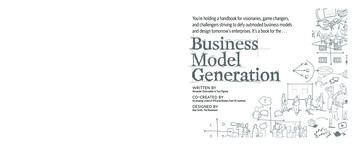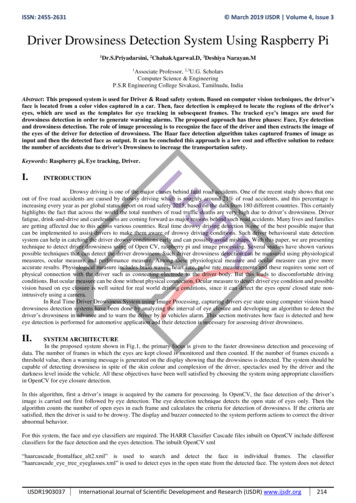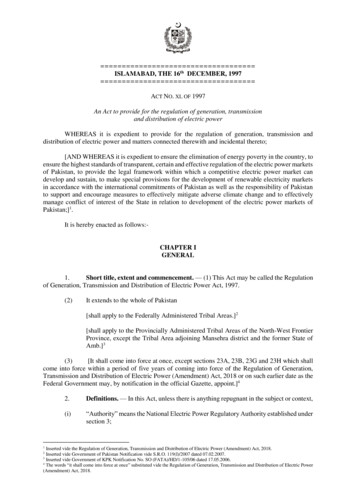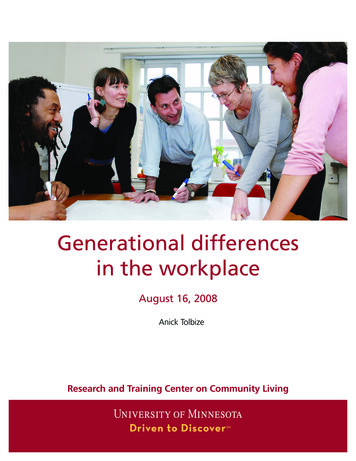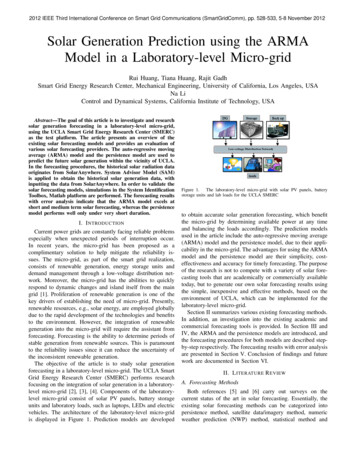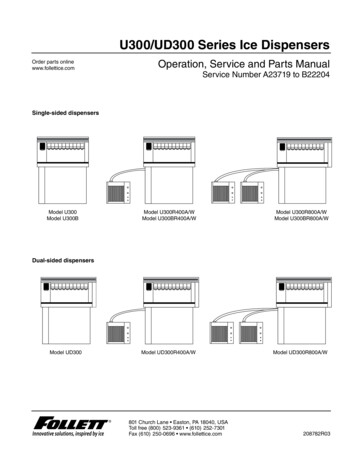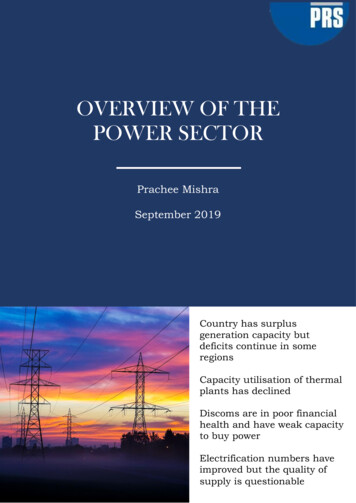
Transcription
Nawaporn Danvirutai1Pinyo Rattanaphan212Creative business practitioner and currently a 2nd year enrollee of College of Graduate Studyin Management Khon Kaen University. Co-founder of Markoff Coffee Roastery Co., Ltd.Lecturer at College of Graduate Study in Management Khon Kaen University. OrganizationDevelopment consultant. Founder of www.aithailand.orgAbstractThis independent study is an inductive method on Appreciative Inquiry basis which aimsto generate a business model for specialty coffee roasting business. The researcher collecteddata from consumers, customers, staffs, producers, processors, farmers, business owners alongwith specialists and experts from many related sciences using purposeful sampling. Data miningand digesting processed on the basis of Appreciative Inquiry Theory which composes of Discovery,Dream, Design and Destiny combined with business model generation using Business ModelCanvas technique.The researcher analyzed discussions of the business conceptual framework and ideaswith businesspartners together with the data collected: to design, create, and develop a businessmodel for specialty coffee roasting business. Of which later on the model had been carried outto a business model innovation. The application of a business model canvas then led to anestablishment of an actual tangible business named Markoff Coffee Roastery Company Limitedwhich serves niche market demands on specialty coffee segment.In entirety of the study and the development of the business model to the concretebusiness, the researcher has learnt that there is no such thing as a perfect pattern for asuccessful business model generation or instant formulae for sustainable business. As today’sbusiness competitive circumstances require constant innovation, the executives mustunceasingly re-evaulate their organization’s business model. Modern managers must becomeadept to ambidextrous thinking: Exploiting their current business model whereas exploringalternative business models. In this age of expeditious change, organizations must adapt to survive.And wise leaders would be able to lead the organization towards their destination.Keyword : Business model ,Canvas Value Proposition Design ,Coffee Micro-RoasterThe National and International Conference onBusiness Management and Innovation 2015 (NICBMI 2015)121Strategic Management and Small and Medium-sized Enterprise ManagementBUSINESS MODEL GENERATION USING BUSINESS MODEL CANVAS ; A CASESTUDY OF MARKOFF COFFEE ROASTERY CO., LTD.
Strategic Management and Small and Medium-sized Enterprise ManagementINTRODUCTION“Coffee” is one of the world’s most famous beverages with a long history behind.Evidences have revealed human’s relation with coffee drinking behavior in the fifteenth centurysince human first discovered a stimulative effects of coffee in Yemen, Arabia and NortheasternEthiopia. For centuries, coffee drinking culture had been spreading from Muslim’s world to Europe,across continents to America, Indonesia and all over the world.[1] [2] [3]Coffee is a drink prepared by brewing of roasted coffee beans, which were processedfrom the seeds of coffee cherries. Coffee were largely consumed with the averages of over 2.25billion cups per day all over the world, while coffee plants could only be cultivated in around70 countries, in the equatorial regions called “Bean Belt” that have optimal climates and environment.[4]Coffee culture has been evolved a lot in the latest century. Human have more knowledgeand understanding of coffee art and science which effected with consumers’ behavior to havemore complexity and more appreciatively meticulous ways of drinking.[5] According to thestatistics, coffee is one of the most value agricultural commodities that only export value alonealready exceeds 35,000 million U.S. dollar/year. [6]Thailand is one of the countries that are fortunate enough to be on the Bean Belt regions.Over a century of coffee cultivation, Thailand’s coffee farming sector reflects an unfavorablesupports from the government and related organizations which results in lack of developmentand now walking a long way behind neighboring countries like Vietnam and Indonesia. Thailandcoffee business sector values over 30,000 million Baht/year with a growth rate of 10% each year.People in Thailand consume over 70,000 tons of coffee per year but this figure is still a lot lesswhen we calculated into a per capita, Thai people drink the average of 200 cups/person/daycomparing with developed countries like Japan and the U.S.A. that have the averages of 500 and700 cups/person/day respectively. One thing noticeable is that those countries that coffee culturehas expanded, evolved and grown they all have a numerous development relating withspecialty coffee sector. No one would say Thailand coffee business sector is uninteresting. Butwhat would make Thailand coffee business sector jump into another era, the world marketleaders pointed that Thailand must focus on specialty coffee sector. [7]Distinctively, look at the world’s most famous specialty coffee organizations likeSpecialty Coffee Association of America (SCAA) and Specialty Coffee Association of Europe (SCAE),they have been established over 30 years with a collaboration from coffee enthusiasts worldwide while Specialty Coffee Association of Thailand (SCATH) have just founded in the beginningof this year, and that is about how far we are from other countries in the global scale.BACKGROUND AND INSPIRATIONMarkoff Coffee is a small coffee-related organization which runs by a young Thai-bloodedbusiness man/ coffee enthusiast named Mr.Rachanon Ma. Rachanon has been walking down theroad of coffee business world for about a decade after he had found himself undeniably fell inlove with coffee and wants to create change in Thailand coffee business segment. He has been122The National and International Conference onBusiness Management and Innovation 2015 (NICBMI 2015)
QUESTIONSIn Thailand, there are actually some neat coffee farms that have been producing highquality coffee for export. And some of those coffee were bought by coffee companies in othercountries, developed and raised their value, winning awards, creating a good reputation for themand earning some capital for them. Why not for our country? Why not for Thai people living inThailand?OBJECTIVETo generate a business model for a specialty coffee roasting business.The National and International Conference onBusiness Management and Innovation 2015 (NICBMI 2015)123Strategic Management and Small and Medium-sized Enterprise Managementdedicated his time and resources for a development and better understanding of coffee withpassion driven. Once he reached the point where Markoff Coffee Shop can stand by itself he isready to step up to another level, coffee roasting. Even though, there are a long way from coffeebeans to coffee brewing and every little step effects the value stream that streaming down tothe cup for consumers. Coffee roasting process is one of the most vital procedures that can flipcoffee value like chalk and cheese and vise versa. Rachanon visions the next step of the evolution in Thailand’s coffee business sector that micro-roasters and specialty coffee developmentmust play a major roles.Zenith: Mind Terrace is a small creative business development organization runs bymyself with helps from some co-creators and friends. I personally interested to investing in abusiness start up in food and beverages segment especially in a coffee sector since I have beengrowing up traveling and being in a western circumstances. I have seen how grow the coffeebusiness is in a global scale. I have experienced seeing how coffee have been blended and beingan essential composition in human’s everyday life.A ringer in my mind keep asking me how could coffee business in Thailand jump to abetter scenario. I do love coffee a lot but I seldom drink coffee in Thailand because I had foundthat despite how Thailand has coffee shops scattering in almost every corner, yet they barelymeets my satisfaction, until once I found Markoff Coffee Shop down a tiny alley in my hometown.Mr.Rachanon Ma is happen to be my school senior that I have been a familiar with fora long time. To see him passionate about coffee and build his own brand up on his way is reallyinspiring. His eye- catching business management style was marked to my interest. And one dayI was blessed enough to have asked by Rachanon to co-create a new business from his mindfulplan, then we invest together and found a company called Markoff Coffee Roastery which wouldserve niche market demands on specialty coffee segment. With a goal to develop and make fameof Thai specialty coffee to the world.Nonetheless, a good business idea and a good business model are not the same thing.As a result, Zenith: Mind Terrace envisioned how important a good business model is and suggested we should generate a good business model using business model canvas technique.
Strategic Management and Small and Medium-sized Enterprise ManagementEXPECTED OUTCOMES1. Understanding of the logic and processes behind business model generation bybusiness model canvas method.2. Ability to use and apply business model canvas in reviewing or analyzing morebusiness models.3. Having a business model for an establishment and development of a specialtycoffee micro-roaster company.4. Having a business model canvas for Markoff Coffee Roastery Co., Ltd. for the use ofinternal and external organization communication.5. Being a source of learning and education for people who are interested.LITERATURE REVIEWAppreciative InquiryAppreciative Inquiry (AI) is a conjointly learning process on the basis of an art of observationand asking without any limited condition. In order to search for the most positive experiencewithin person or process in the organization, in this world and in the environment. [6]A systematic discovery process of Appreciative Inquiry drives an eager to search for realcauses which make the best from the process. Especially, when the process yield highestefficacy regardless any dimension it is. [8]AI is building on the hypothesis that each and every system or unit always has a hiddenpositive stories behind, in person or in the organization. And those positive stories are the thingthat would be of great impact to enlighten, expand and grow economically and socially.AI cycle or 4D-Cycle composes of 4 processes which are Discovery, Dream, Design andDestiny. Starting by gathering data and information then use those information to dream or visionof an imaginary result that wanted most. Following by designing how to process to make thatdreams or visionaries come true. And lastly, to bring those design into an action. Moreimportantly, every steps must be driven on a positive core. [9] [10]Business Model GenerationRecently people have been talking about business models, but what is a businessmodel. It is a way to conceptualize and understand organizations. As systems that have commoncomponents. An organization business model can be described in nine basic building blocks. 1.Customer Segments, 2. Value Propositions Segment, 3. the Channels to reach customers,4. Customer Relationships established, 5. Revenue Stream generated, 6. Key Resources and 7.Key Activities required to create value. 8. Key Partnerships and 9. a Cost Structure of the businessmodel. But it is not sufficient to just enumerate the nine building blocks. What we really want todo is to map them out in a pre-structured canvas. The tool that helps us map, design, discussand invent a new business model.To briefly go to the nine building blocks, starting with the Customer Segments. These areall the people and organization which we creating value for. Then we have a specific segmentfor Value Propositions. These are bundles of products and services that create value for our124The National and International Conference onBusiness Management and Innovation 2015 (NICBMI 2015)
METHODOLOGYThis independent study is an inductive method on Appreciative Inquiry basis which aimsto generate a business model for specialty coffee roasting business. The researcher collecteddata from consumers, customers, staffs, producers, processors, farmers, business owners alongThe National and International Conference onBusiness Management and Innovation 2015 (NICBMI 2015)125Strategic Management and Small and Medium-sized Enterprise Managementcustomers. Channels describe through which touch-points we interact with customers anddelivering value. Customer Relationships outline the types of relationship we establishing withthe customers. The Revenue Streams make clear how and through which pricing mechanism ourbusiness model is capturing value. Then we need to describe the infrastructure to create,deliver and capture value. The Key Resources show which assets are indispensable in ourbusiness model. The Key Activities show which thing we really need to be able to perform well.Key Partnerships show who can help us leverage our business model. Since we would not ownall resources by ourselves nor we perform all key activities. Then once we understand ourbusiness model infrastructure we will also have an idea of its cost structure.So, with the business model canvas, we can map out our entire business in one imageand this works well for both start up business entrepreneur and most senior executives. [11] [12]Value Proposition DesignValue Proposition Canvas is the tool that will help us design, test, build and managegreat customer value propositions. Like a plug-in to the business model canvas, the tool basedon two related structures which are Customer Segments whom we intend to create value forand Value Propositions which we believe will attract the customers. With the value propositioncanvas, we can map out both in more granularity. And show the fit between what we offer andwhat customers want.The customer segment profile describes the characteristics of our customers in moredetails. The profile is composed of the jobs customers try to get done, the related painsoutlining the negative aspects they hate and would like to avoid, the gains describing the positiveoutcomes and benefits which our customers would like to have. These three elements in thecustomer segment profile describe the customers characteristics that we can observe in themarket.Then look at the value proposition map. It describing the features of the valueproposition which we are designing to address our customers’ most important jobs, pains andgains. The map is composed of the products and services our value is built around, the painrelievers outlining how our products and services can alleviate the customers’ pains and the gaincreators describing the positive outcomes and benefits our products and services create for ourcustomers.If the two sides are matched and fits and the market validates this match our valueproposition get attracted to real customers in the market, we have achieved the so called“Product-Market Fit”.Nevertheless, successful businesses have more than just a great value proposition. Theyhave a great business model that mkae the value proposition possible. [13]
Strategic Management and Small and Medium-sized Enterprise Managementwith specialists and experts from many related sciences with the total of 40 samples usingpurposeful sampling. Data mining and digesting processed on the basis of Appreciative InquiryTheory which composes of Discovery, Dream, Design and Destiny combined with businessmodel generation using Business Model Canvas technique.The samples were divided into three groups. Firstly, Markoff Coffee’s customers.Secondly, coffee business-related professionals such as baristas, coffee shop owners, coffeeprocessors and coffee farm owners. And lastly, coffee lovers and coffee enthusiasts.The researcher analyzed discussions of the business conceptual framework andideas with business partners together with the data collected: to design, create, and develop abusiness model for specialty coffee roasting business.RESULTS1. Markoff Coffee Roastery Co., Ltd. ‘s Value Proposition Canvas as illustrated infigure 1Figure 1 Markoff Coffee Roastery Co., Ltd. ‘s Value Proposition Canvas126The National and International Conference onBusiness Management and Innovation 2015 (NICBMI 2015)
Figure 2 Markoff Coffee Roastery Co., Ltd. ‘s Business Model CanvasCONCLUSIONSThe business model of Markoff Coffee Roastery Co., Ltd. can be described in these ninebuilding blocks. Firstly, the Customer Segments which compose of coffee shop owners,professional baristas, and coffee lovers/ home users. Secondly, values were created using ValueProposition Canvas. The Value Propositions Segment ended up containing of five main valueswhich are high quality premium commercial grade coffee, Thai specialty coffee, importedspecialty coffee, Cup of Excellence grade coffee and Markoff Buddy Program. Values created thenare mainly delivered through internet-base channel via www.markoffcoffee.com that easily linkwith social media platform, and some through partners and chain distributors with helps fromlocal and international logistics providers. Revenue streams are coming from premium qualitycommercial grade roasted coffee products, specialty coffee grade products and additionalservices e.g. the Markoff Buddy Program.The key resources are 1. high-technology and efficiency coffee roasting machines likeProaster and Probat, 2. coffee experts, roasters, sensory masters and coffee lover personnels,3. innovative roasting software and management program. 4. high quality green coffee beansources. With our key activities which are roasting, research and development, branding andmarketing.Key partnerships compose of a joint collaboration between Markoff Coffee Shop andZenith: Mind Terrace, with assistance from Markoff Coffee Academy. D’presso Coffee RoastersThe National and International Conference onBusiness Management and Innovation 2015 (NICBMI 2015)127Strategic Management and Small and Medium-sized Enterprise Management2. Markoff Coffee Roastery Co., Ltd. ‘s Business Model Canvas as illustrated in figure 2
Strategic Management and Small and Medium-sized Enterprise Managementwho help us with a mass production. Finca el Bechequ is the farm with volume of various premium green coffee bean products. Moreover, logistics providers are also help with distributing.Cost structure mainly lies in green coffee bidding, platform development, operationcost, management cost, logistics cost, product and packaging development cost and brandingand marketing cost.DISCUSSIONIn entirety of the study and the development of the business model to the concretebusiness, the researcher has learnt that there is no such thing as a perfect pattern for asuccessful business model generation or instant formulae for sustainable business. As today’sbusiness competitive circumstances require constant innovation, the executives mustunceasingly re-evaluate their organization’s business model. Modern managers must becomeadept to ambidextrous thinking: Exploiting their current business model whereas exploringalternative business models. In this age of expeditious change, organizations must adapt to survive.And wise leaders would be able to lead the organization towards their destination.ACKNOWLEDGEMENTFirstly, I would like to express my sincere gratitude to my generous adviser Dr.PinyoRattanaphan who provided insight and expertise that greatly assisted the study. Thank you forhis continuous support of my master degree study, for his patience, motivation, kind heart,positive soul and immense knowledge. His guidance helped me all along my journey of thisindependent study. I could not have imagined having a better advisor and mentor for mygraduate school study program.Besides my advisor, I would like to thank the rest of lecturers, staffs, and courses ofCollege of Graduate Study in Management, Khon Kaen University for a meaningful andlife-changing business education and experiences that have widen my vision from variousperspectives.And I would also like to show my deepest gratitude to my family and my fiancé whoalways be there for me and help supporting me in every possible aspect.My sincere thank also goes to Mr.Rachanon Ma and his family, for being a positiveenergy that energizing my coffee business enthusiasm and passion. His visions, approaches andperspectives in organization development have been a great model for me to learn and toprosper.I thank Strategyzer for providing a creative and better visionary ways of education to theworld.Lastly, my heartfelt thank goes to all collaborations of Appreciative Inquiry practitionersthat help spreading knowledge seeds all over the world for everyone.128The National and International Conference onBusiness Management and Innovation 2015 (NICBMI 2015)
The National and International Conference onBusiness Management and Innovation 2015 (NICBMI 2015)129Strategic Management and Small and Medium-sized Enterprise ManagementREFERENCES[1]Weinberg, B. A. & Bealer B. K. (2002). The World of Caffeine: The Science and Cultureof the World’s Most Popular Drug. New York: Routledge.[2]Banks, M., McFadden, C., & Atkinson, C. (2011). The World Encyclopedia of Coffee: TheDefinitive Guide to Coffee, from Simple Bean to Irresistable Beverage. Leicestershire:Hermes House.[3]Hoffmann, J. (2014). The World Atlas of Coffee: From Beans to Brewing - CoffeesExplored, Explained and Enjoyed. London: Octopus Publishing.[4]International Coffee Council. (2014). World Coffee Trade (1963 - 2013): A Review ofthe Markets, Challenges and Opportunities Facing Sector. ICC 111-5 Rev.1. London:International Coffee Organization.[5]CoffeeKind. (2013). The Three Waves of Coffee. Retrieved on 22nd March 2015, fromhttp://coffeekind ted Nations. (2014). 2013 International Trade Statistics Yearbook, Vol. II Trade byProduct. New York: United Nations.[7]Arunmas, Pusadee. (2012). Bangkok Post, Economics, BEVERAGES, Thailand’s coffeesector ‘must focus on specialties’. Retrieved on 27th December 2014, from [8]Cooperrider, D. L., & Whitney, D. A. (2005). Positive Revolution in Change: AppreciativeInquiry. San Fransisco: Berrett-Koehler Publishers.[9]Rattanaphan, Pinyo. (2009). What is Appreciative Inquiry?. Retrieved on 18th December2014 from www.aithailand.org[10] Cooperrider, D. L., Whitney, D., & Stavros, J. M. (2008). Appreciative Inquiry Handbook:For Leaders of Change. Ohio: Crown Custom Publishing.[11] Clark, T., Osterwalder, A., & Pigneur, Y. (2012). Business Model You: A One-PageMethod for Reinventing Your Career. New Jersey: John Wiley & Sons.[12] Osterwalder, A., & Pigneur, Y. (2010). Business Model Generation: A Handbook ofVisionaries, Game Changers, and Challengers. New Jersey: John Wiley & Sons.[13] Osterwalder, A., Pigneur, Y., Bernarda, G., Smith, A., & Papadakos, P. (2014). ValueProposition Design. New Jersey: John Wiley & Sons.
1. Understanding of the logic and processes behind business model generation by business model canvas method. 2. Ability to use and apply business model canvas in reviewing or analyzing more business models. 3. Having a business model for an establishment and development of a specialty coffee micro-roaster company. 4.
